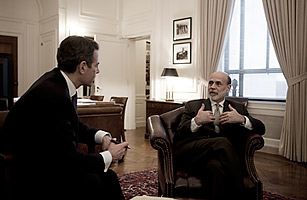
TIME's Managing Editor Richard Stengel talks with Federal Reserve Chairman Ben Bernanke during an interview in Washington, DC
(7 of 12)
I think an example I would give you would be in the early 1980s, when the U.S. was suffering from serious inflation, one of my predecessors, Paul Volcker, tightened monetary policy and raised interest rates [to roll] back inflation. The side effect of that action was to create a significant recession, about as bad as the one we're currently experiencing. And that was, of course, extraordinarily unpopular. And one of the things that happened was that people were sending into the Federal Reserve two-by-fours. I'm going to show it to you. Here's an example passed down to me, two-by-fours on which were written some things that weren't so printable, some that were more printable.
I hope that's a printable one.
Yes, this is a printable one. Asking the Federal Reserve to lower interest rates.
Well, save the housing industry. I see.
Save the housing industry. Yes.
I do remember my first home I bought, where the VA loan was 15 1/2%.
It was probably in the '80s.
Yes, well, late '70s, 15-1/2%, so times were different.
That's right. So, there was a very difficult period...
Houses were cheap.
A lot of grief, a lot of unpopularity, but those decisions were the right ones, and breaking the back of inflation was the basis for 20-plus years of growth and prosperity.
Has no one mailed you anything?
No one has mailed me anything, so far, but I don't want to invite that. (Laughter.)
Right now people are sort of looking to you, and to Congress, to kind of break the back of unemployment. And you've talked about how that is really our biggest challenge right now. Do you feel there is anything else that can be done, or has the Fed shot all its bullets, and has Congress shot all its bullets?
Well, the Federal Reserve has been very aggressive on the unemployment side. So, let me just first say that even though the recession may be technically over., in a sense that the economy is growing, it's going to feel like a recession for some time, because unemployment remains very high, about 10%. And even people who have jobs, there are many people who are on short hours, that are in voluntary part-time, or maybe people who are not technically unemployed, only because they stopped looking. So, the labor market is in very weak condition, and we're not going to see a healthy, vibrant economy again until the labor market — the job market — has recovered. So, that is really an extraordinarily important objective for policy going forward. And, certainly, our job won't be done until the economy is growing again, and jobs are being created.
The Federal Reserve's attempts to address employment issues, we've done several things. Certainly, one of the things is we're using our monetary policy. In December 2008, while the crisis was still in an intense phase, we cut the short-term interest rate that is the measure of our monetary policy almost to zero. The first time that had ever been the case, the Fed had ever done that, in order to provide the maximum amount of support to the economy, and it remains close to zero today. So, that is a very powerful measure.
Having used that tool to its maximum extent, we have then turned to new and innovative tools, things that have never been done before in the Federal Reserve. I'll give you two examples. One, we've purchased about $1 trillion worth of mortgages that are guaranteed by Fannie Mae and Freddie Mac, and the U.S. Treasury. And in doing those purchases, we have succeeded in reducing the national 30-year fixed-rate mortgage rate from about 6-1/2% to about 4.8%. By lowering mortgage rates that way, we have helped to stabilize the housing sector, to help stabilize the housing crisis, and allow people to refinance, to buy homes. And that, obviously, should get construction started again and house prices stabilizing, and people being able to meet their mortgages. That's obviously going to be helpful.
We've also created a program that helps bring credit from Wall Street to support a wide variety of consumer and small-business loans. So, for example, our program allows Wall Street money to come in and support auto loans, credit card loans, student loans, small business loans, commercial real estate loans. By providing that conduit, we are supporting what the banks are doing to get credit flowing into those important sectors.
And I guess a third thing, an additional thing I would mention is that we serve not only as monetary policy makers, but also as bank supervisors. And there we've been sparing no effort, as I talked about earlier, to get the banks able and willing to lend again, to create — particularly the small businesses — to create the credit that's needed to create new jobs and get employment back on track.
I would mention, in particular, our leadership of the stress tests. In the spring, the Federal Reserve led an effort to evaluate the balance sheets of 19 of the largest banking companies in the U.S., and our report on those balance sheets, along with the FDIC, the OCC, to other banking agencies, our reports on those balance sheets is public, greatly increased the confidence in the banking system, which meant that they were able to go out and raise new capital in the stock market, and many of them have paid back the capital to the government. But by raising new capital, they increased their own capacity to lend. And, as conditions improve, they'll be able to make new loans as well.